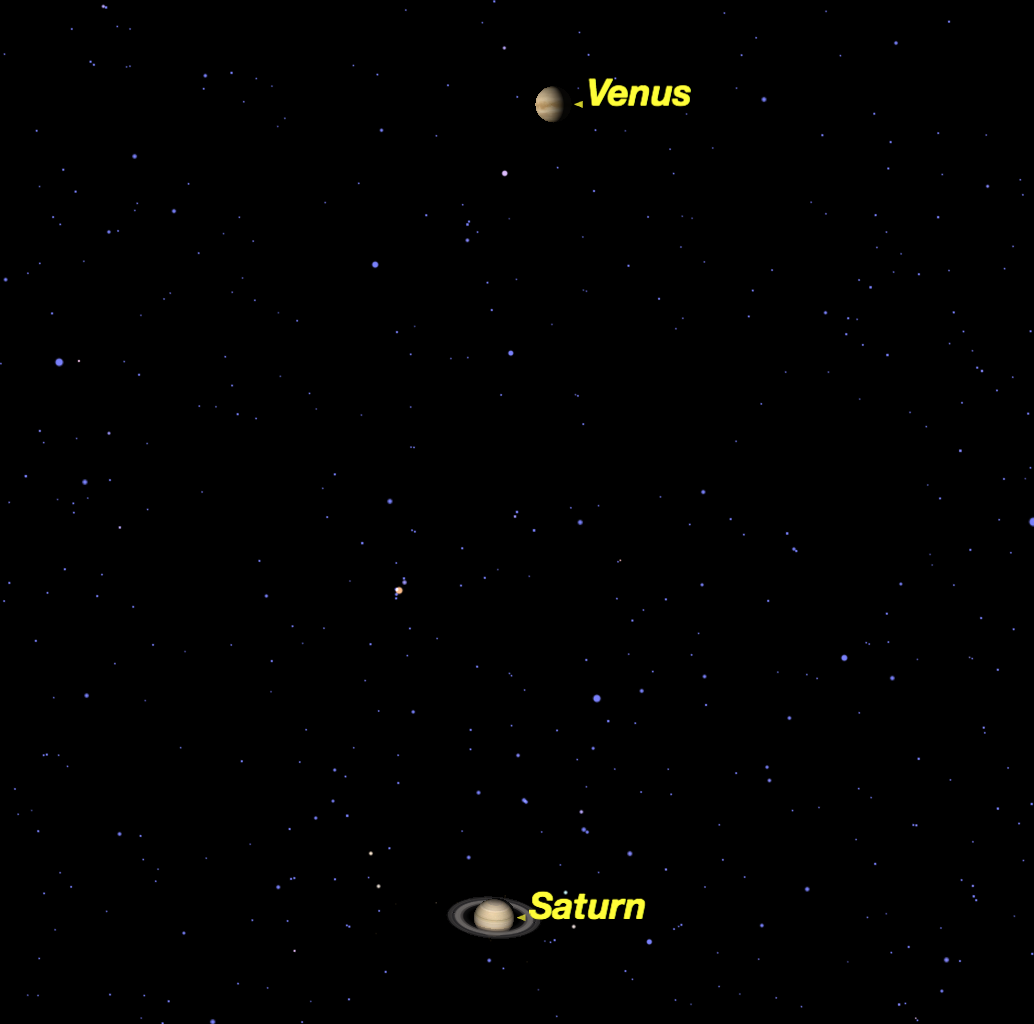Venus Shines Near Saturn in Dazzling Display This Weekend

On Friday (Jan. 8), the planet Venus will appear to pass close by Saturn, making this a rare opportunity to see two planets at the same time in a telescope's narrow field of view.
During the planetary encounter, Venus will appear to pass just 5 arc minutes north of Saturn. That means the distance between the two planets will appear to be a mere one-sixth of the diameter of the moon, small enough to fit in the eyepiece of a powerful telescope.
In a lifetime of observing the skies, I have seen such a close conjunction of two planets only two or three times. With the naked eye, even sharp-eyed observers will be hard pressed to separate the two points of light. [January's Night Sky: Planets, Giant Stars and More (Video)]
Unfortunately for observers in North America, the point of closest conjunction will occur at 11 p.m. EST, while the planets are below the local horizon. For a skywatcher in New York, for example, the planets won't clear the eastern horizon until 5 a.m. on Saturday morning (Jan. 9). At that time, the planets will have separated so that they are 17 arc minutes apart, or slightly more than half the diameter of the moon. Even so, they will still fit in a telescope eyepiece.
Of course, this conjunction is something of an optical illusion. The two planets aren't anywhere near each other in space, but merely appear close together from the perspective of observers here on planet Earth.
Venus is currently on the far side of the sun from Earth, at a distance of 1.22 astronomical units, or AU. (One AU is the average distance from the Earth to the sun — about 93 million miles, or 150 million kilometers). At this distance, Venus appears similar to a gibbous moon.
Saturn is 10.79 AU from Earth, nearly nine times farther away than Venus is.
Get the Space.com Newsletter
Breaking space news, the latest updates on rocket launches, skywatching events and more!
The two planets appear to have almost the same angular diameter: 14 arc seconds for Venus, 15 arc seconds for Saturn. However, in reality Saturn is actually almost 10 times the diameter of Venus. So Saturn's greater distance balances out the ringed planet's larger size, and the two bodies appear almost the same size from Earth.
The most striking difference between the two planets is their contrast in brightness. Venus is magnitude -4.0 on the upside-down brightness scale astronomers use, while Saturn is only magnitude +0.5, or 4.5 magnitudes (almost 100 times) fainter than Venus. This difference is mainly due to Venus' closeness to the sun (0.72 AU) compared to Saturn's (9.55 AU).
When you look for the twin planets just before dawn on Saturday morning, the first thing you will notice is Venus shining brightly in the southeastern sky. You will have to look closely to spot "tiny" Saturn just above and to the right of Venus.
If you own a planetarium program like Starry Night that lets you travel virtually to other planets, check out the view Saturday morning from Saturn. You will see Earth and Venus in a close conjunction, Venus a narrow crescent from Saturn's perspective, and Earth a rounded, gibbous shape. This is because, despite being close together in the sky, Venus and Saturn are actually on opposite sides of the sun, and lit by the star quite differently.
Editor's note: If you capture a great photo of Venus and Saturn together this weekend and want to share it with us and our news partners for a story or gallery, we want to know. Send your images and comments in to: spacephotos@space.com.
This article was provided by Simulation Curriculum, the leader in space science curriculum solutions and the makers of Starry Night and SkySafari. Follow Starry Night on Twitter @StarryNightEdu. Follow us @Spacedotcom, Facebook and Google+. Original article on Space.com.
Join our Space Forums to keep talking space on the latest missions, night sky and more! And if you have a news tip, correction or comment, let us know at: community@space.com.

Geoff Gaherty was Space.com's Night Sky columnist and in partnership with Starry Night software and a dedicated amateur astronomer who sought to share the wonders of the night sky with the world. Based in Canada, Geoff studied mathematics and physics at McGill University and earned a Ph.D. in anthropology from the University of Toronto, all while pursuing a passion for the night sky and serving as an astronomy communicator. He credited a partial solar eclipse observed in 1946 (at age 5) and his 1957 sighting of the Comet Arend-Roland as a teenager for sparking his interest in amateur astronomy. In 2008, Geoff won the Chant Medal from the Royal Astronomical Society of Canada, an award given to a Canadian amateur astronomer in recognition of their lifetime achievements. Sadly, Geoff passed away July 7, 2016 due to complications from a kidney transplant, but his legacy continues at Starry Night.
